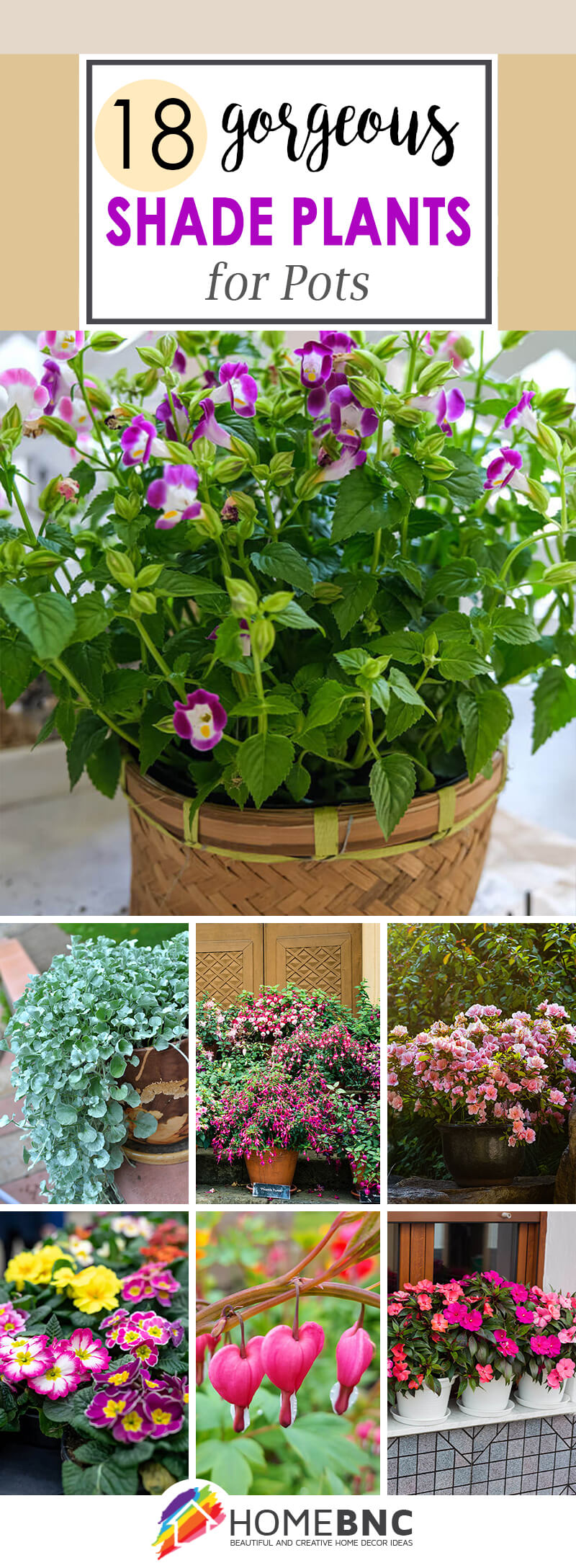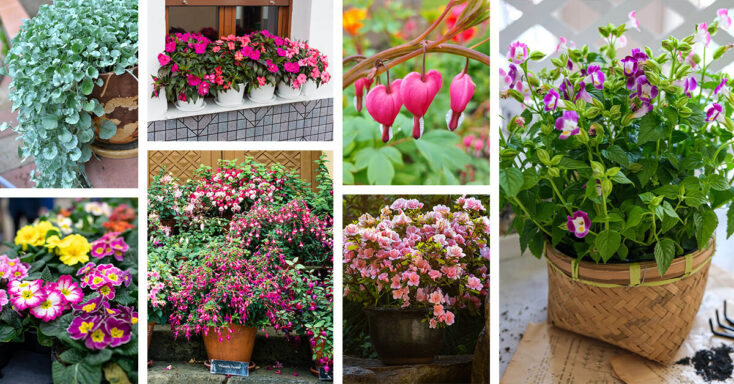Use shade plants for pots to brighten up dark corners in the garden. Shaded areas are a fantastic opportunity to grow these gorgeous plants. Shade plants are special. They need protection from too much sunlight. From fascinating foliage to dramatic brightly colored flowers, plants that grow in the shade are incredibly useful. And beautiful too! Graceful and luscious, shade plants for pots usually like to be kept moist, like in a naturally shady forest setting. The great part is moisture stays in soil longer without the drying effects of the sun. This makes shade plants in pots easier to maintain while they continue to look vibrant and gorgeous.
Key Takeaways
- Shade plants for pots come in all shapes and sizes making wonderful thrillers, spillers, and fillers.
- Just like plants in naturally shady areas, many shade plants for pots have fascinatingly beautiful foliage.
- Colorful bedding plants known for their months of vibrant flowers have lots of versions that make perfect shade plants for pots.
- Perennials make excellent shade plants for pots too, and they can be planted out where you want them at the end of the season.
- Shade plants for pots can stay in their container to become adaptable adorable houseplants.
18 Beautiful Shade Plants for Pots that are Perfect for Less Sunny Gardens
1. Fuchsia (Fuchsia)
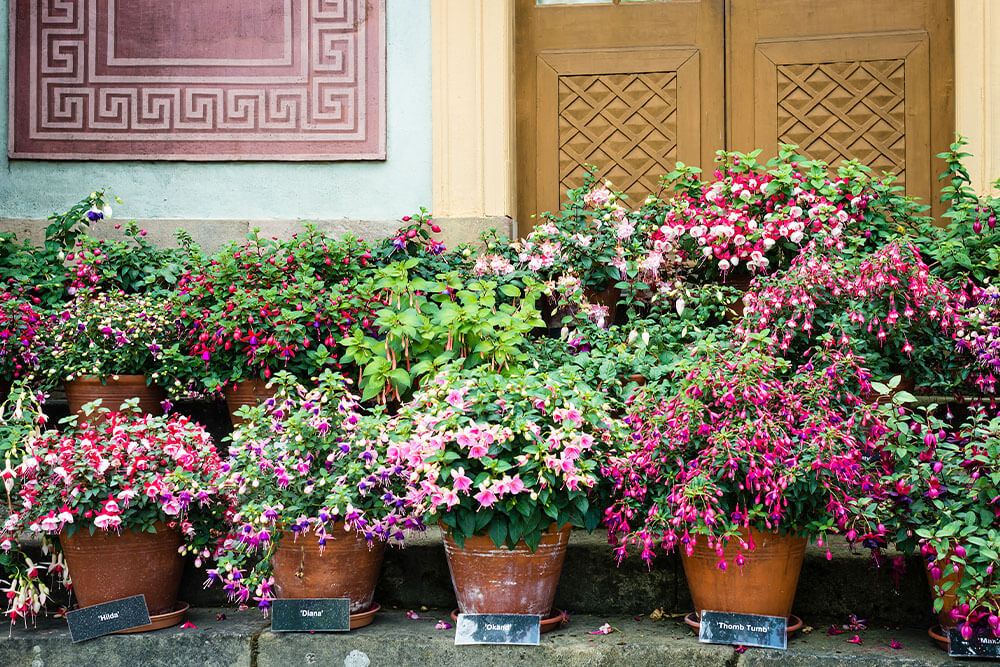
Always delightful, Fuchsia has thousands of cultivars to consider. Known for their prolific, pendulous flowers, Fuchsia blooms nearly all season long. And they thrive in the shade. They love moist warm conditions with protection from wind. Fuchsia can handle some dappled sunlight but certainly avoid hot direct sun.
An easy plant to grow in the right conditions, Fuchsia will reward you with brightly colored single, or double flowers in reds, pinks, and purples. Many flower forms have unique contrasting colors. The natural cascading growth habit is elegant, perfect for pots in shady areas.
2. Bleeding Heart (Dicentra)

This spring bloomer has gorgeous red, heart-shaped flowers that dangle deliciously from pendulous branches. Often grown as a perennial, hardy in USDA zones 4 to 8, Bleeding Heart is an incredible shade plant for pots. Many cultivars have deeply lobed, or finely divided fern-like leaves to create interest in your shade pots well after the blooms have passed. Late in the season when other shade plants for pots have grown to their full size, the foliage of Bleeding Heart will take backstage. And even better, the plants can be popped out and planted in the garden to come back next spring.
3. Coral Bells (Heuchera)
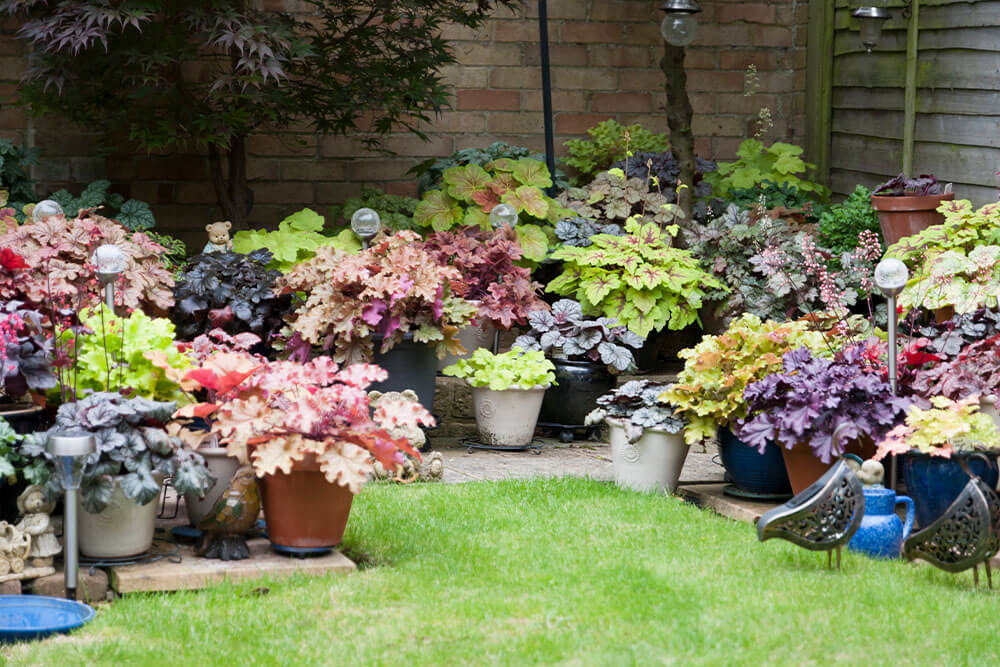
Another incredible foliage plant for shade is Coral Bells or Heuchera. They work amazingly well in containers, and like Bleeding Heart, they grow well in the garden as perennial plants in USDA hardiness zones 4 to 9. In fact, Coral Bells is a great choice to plant with Bleeding Heart in your pots for shade because when the Bleeding Heart has finished its foliage and flower show, Coral Bells is in its prime. And the two can be planted in a shady area of the garden and stay friends next spring.
The gorgeous, scalloped leaves have color variations from the deepest purple to luminescent yellow green. Fairy-like tiny bell flowers dance from delicate flower stalks midsummer to frost.
4. Dichondra (Dichondra argentea)
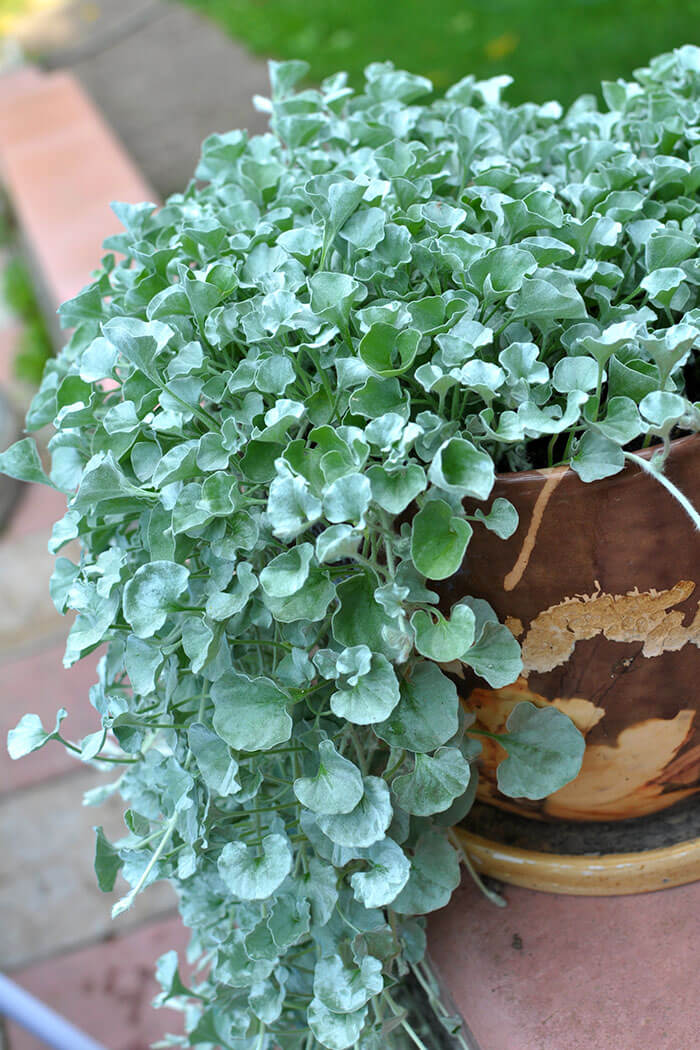
A luxurious spiller, Dichondra has a trailing, creeping habit for overflowing your pots with an abundance of green or silver foliage. Grown as an annual, Dichondra grows only 4 inches tall, but the long shoots can trail up to 4 feet long. An ideal plant for shade but can handle sun too. An hour or two of sun each day is enough to keep Dichondra looking great in the shade. When you need a spiller shade plant for pots, Dichondra is a great choice, especially for tall containers, hanging baskets, and window boxes.
5. Begonia (Begonia)
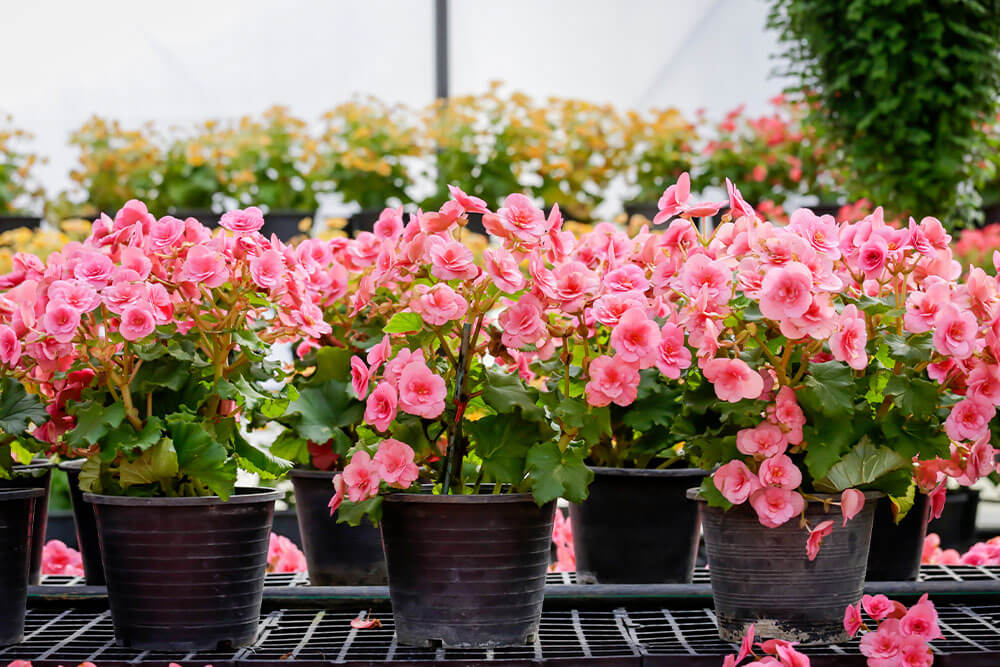
Certainly, the king of shade plants for pots, Begonia has over 1800 species creating hundreds of varieties that are perfect for container gardening in the shade. Blooms rise above interesting leaves in dazzling hues of orange, pink, white, red, and bicolors. Not too wet, and not too dry, with above-average drainage are the secrets to successfully growing healthy, outstanding Begonias that bloom from midsummer to frost. Most varieties are hardy in USDA zones 6 to 11. They grow from tubers or rhizomes. In colder regions the roots can be lifted in the fall, stored, and replanted in spring, once all fear of frost has passed.
6. Lobelia (Lobelia erinus)
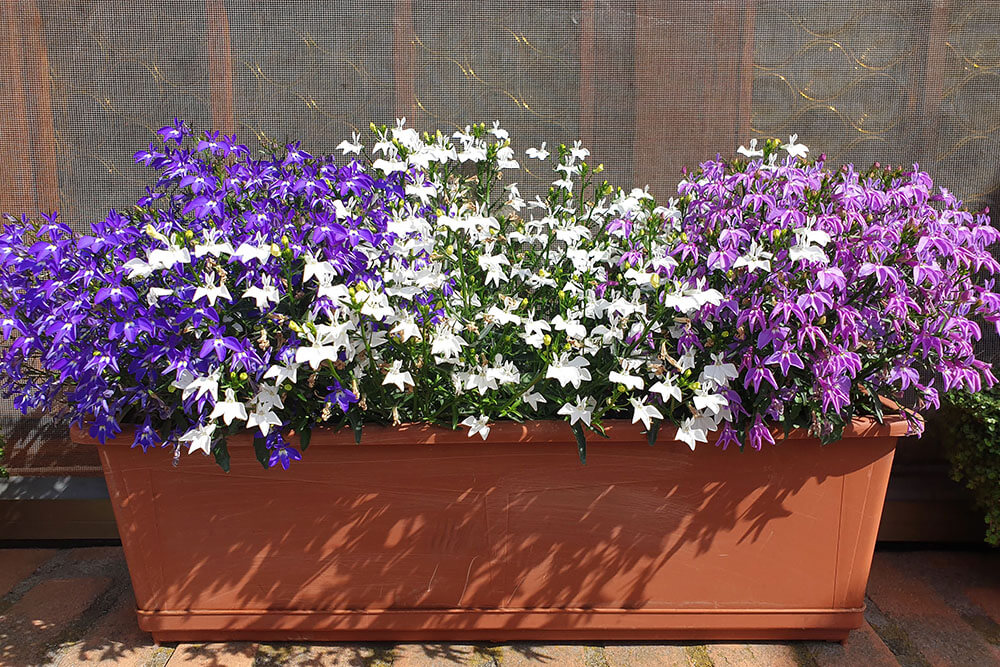
Masses of delicate fan-shaped flowers frolic above upright or trailing stems in blue, violet, pink, and reds. Lobelia is an excellent filler in both sun and shade. It adds movement and muted color which makes it a great companion to just about all shade plants for pots. Normally grown as an annual, Lobelia loves rich, moist, organic soils. After its initial spring show, you can cut Lobelia back. This will give you an even fuller fall-time bloom. Plants will fill container space of about 6 to 12 inches high and wide.
7. Oxalis (Oxalis)
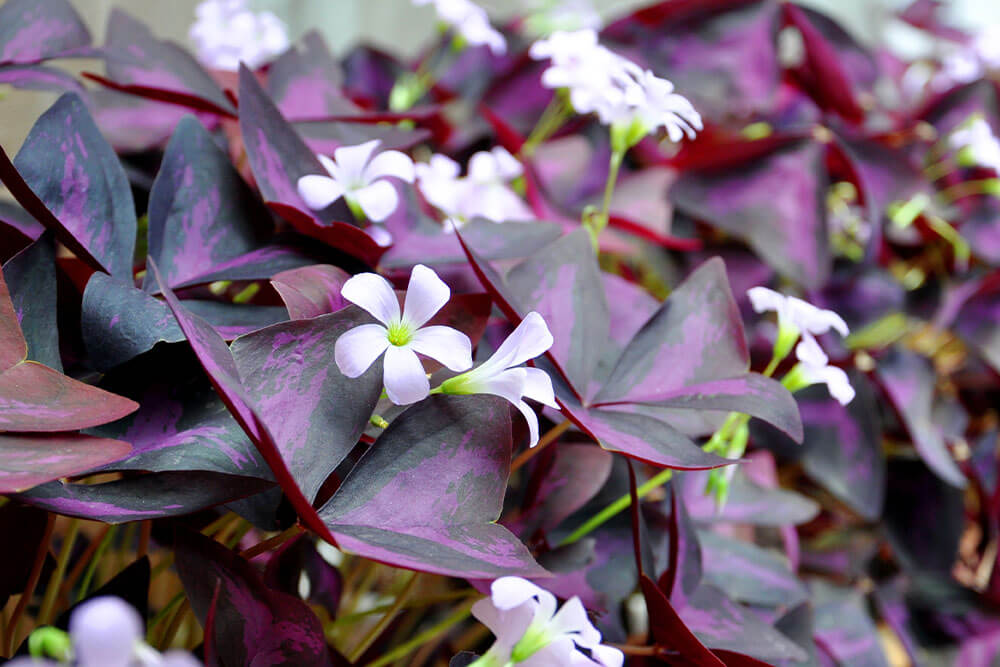
Also known as Shamrock, versions of Oxalis have been used as dutiful houseplants brightening up indoor areas. Who knew these plants are wonderful grown in pots outdoors in shaded areas. And, where the temperatures are cold, you can bring Oxalis in for the winter. The shamrock-like leaves add color and texture to the outdoor shade container garden. In low light, the delicate three-leaflets fold together. Burgundy leaves with blush pink long stemmed flowers is a popular version of this shade plant. There are varieties with multicolored leaves or pure green leaves with flowers of white, pink, yellow, and peach.
8. Impatiens (Impatiens)
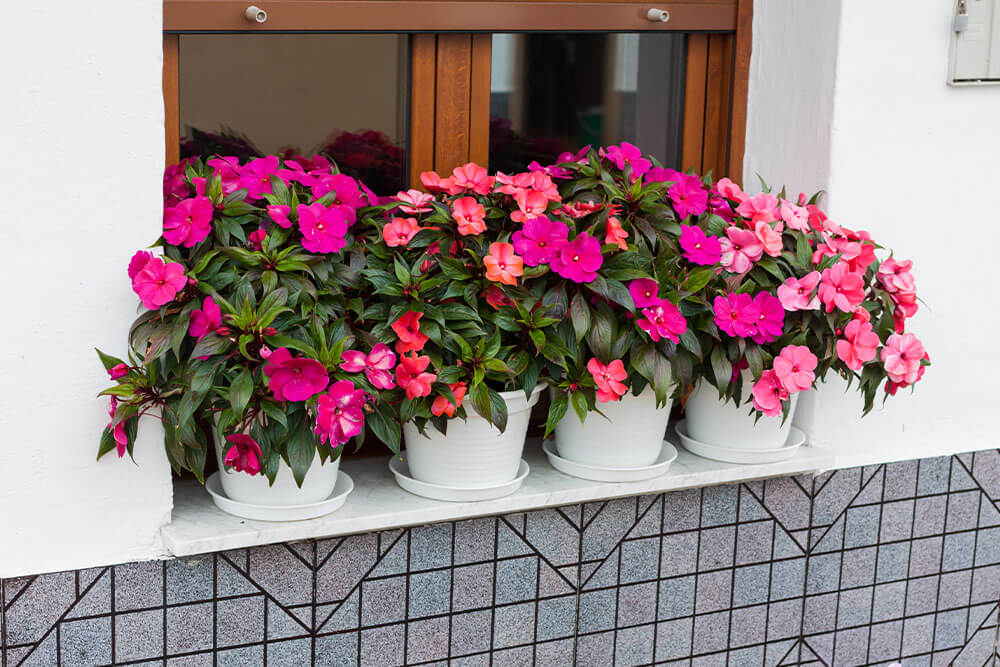
If Begonia is the king of shade plants for pots, then Impatiens are their queen. The incredible vibrant colors that bloom all summer long from June to frost has made Impatiens the shade plant for pots favorite for decades. Plants are small and compact, growing 6 to 24 inches tall and wide. A tender perennial, Impatiens are treated as an annual outside of USDA zones 10 and 11. The continuous blooms in spectacular bright hues of red, pink, purple, coral, lilac, orange, rose, peach, and white can be single- or double-petaled flowers. Impatiens love being pinched back for bushier growth, and they thrive in consistently moist, nutrient-rich soil.
9. Torenia (Torenia fournieri)
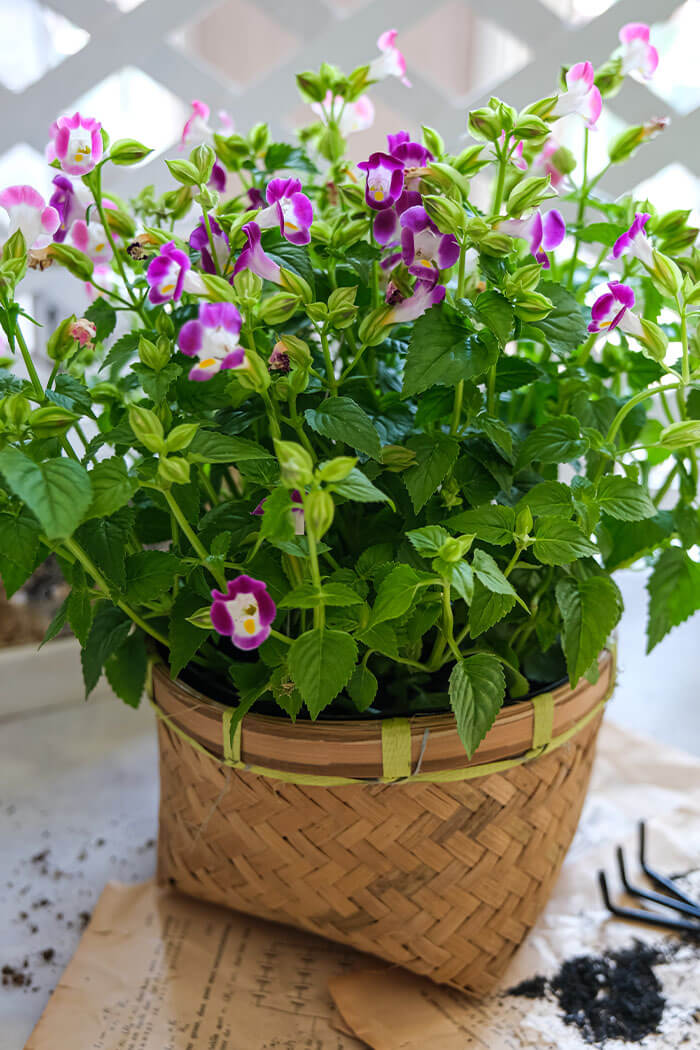
Wishbone flower, also known as Torenia, flowers happily all summer long even in full shade. On the short side, Torenia grows 6 to 18 inches but trails and cascades out of the container, making Torenia a wonderful spiller plant. A surprise benefit to this shade-loving flower is that it’s tolerant of some heat and easy to care for. It doesn’t require deadheading, so the joyful bicolor or tricolor blue, purple, burgundy, pink, white, and yellow trumpet-shaped flowers keep on blooming. Especially in rich, well-drained soils.
10. Monkey Flower (Mimulus ringens)
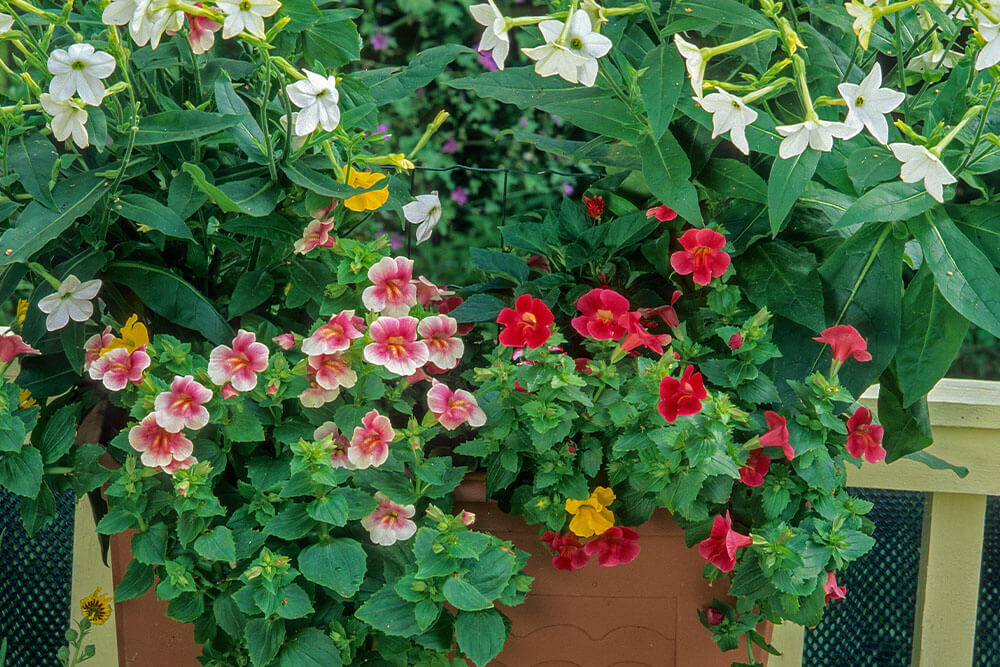
Monkey Flower form an unusual, snapdragon-like flower that is sometimes spotted. With a little imagination, the fun-loving flowers look a little like a monkey face. The long blooming period, common of many bedding plants and annuals, is June to September. Many Monkey Flower varieties come in warm, natural hues of yellow, orange, and red. There are varieties of purple and lilac out there as well. Some of these interesting plants are trailing while others are upright, so there is a spiller or filler plant role to be found in varieties of Monkey Flowers. At home in bog-type environments, Monkey Flower loves moist soils in the shade. It does not like to dry out.
11. Trailing Bacopa (Sutera cordata)
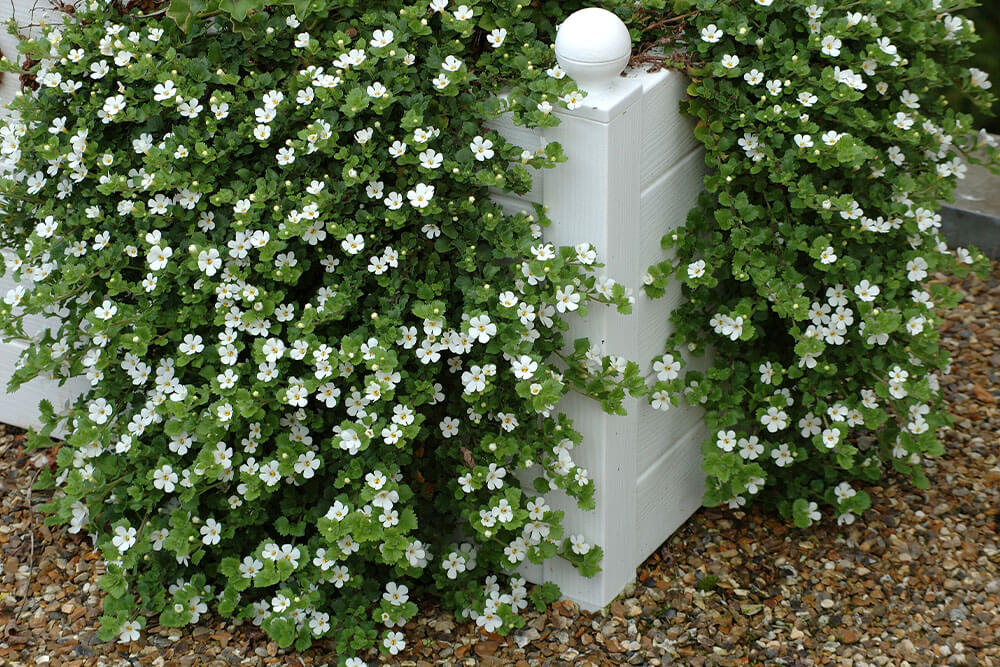
For gorgeous trailing habits and perfect snowflake white blooms, trailing Bacopa is a fantastic shade plant for pots. With new versions of trailing Bacopa being developed you can find frilled flowers and double flowers in colors of pinks, blues, as well as the traditional white. Trailing Bacopa spreads and cascades 2 to 4 feet, overflowing planters, containers, and pots in the shade. The flowers bloom from spring to frost all along the beautiful branches of blue/green foliage. Trailing Bacopa is vigorous and prolific, so it loves extra nutrition. It doesn’t need deadheading but cutting back and removing damaged stems make for luxurious healthy growth.
12. Persian Shield (Strobilanthes dyeranus)
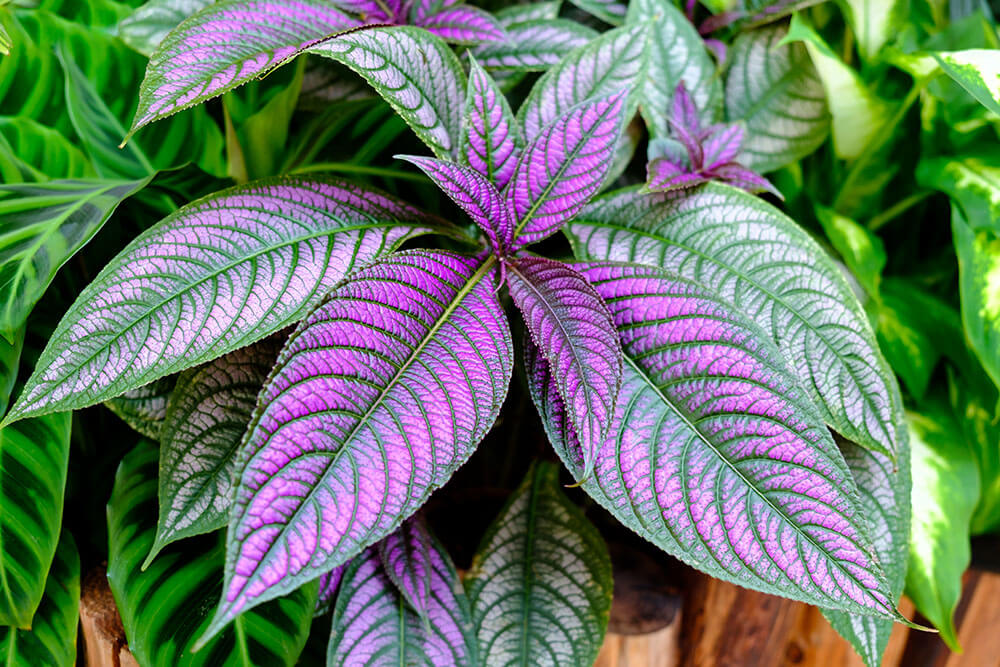
Persian Shield is a stunning broadleaf evergreen with magnificent exotic foliage. An exciting thriller shade plant for pots, Persian Shield takes center stage in containers growing 3 to 4 feet tall. The visually striking leaves can become more dynamic with some sun with deeper contrasts of the purple, green, and silver veins and variegation. And Persian Shield grows easily in part shade. Pinching back stems will help Persian Shield grow full and bushy. This gorgeous foliage plant is normally an annual but is hardy in USDA zones 10 to 11, making it adaptable as a houseplant.
13. Hellebore (Helleborus)

An interesting and bold addition with your shade plants for pots, Hellebore are an early spring blooming perennial. The thick evergreen foliage forms a low-lying clump of lobed or palmate leaves creating a lovely filler in your shade containers. Known as the Lenten rose or Christmas rose, some Hellebore bloom as early as Christmas, while others are later, closer to Easter. At bloom time, the single or double nodding blooms are in nostalgic elegant shades of green, white, pink, and wine. Blooms persist for a long time on 1-to-2-foot plants. To use as perennials, Hellebore are hardy in USDA zones 3 to 9. You can plant them in the shade garden at the end of your container gardening season.
14. Hardy Cyclamen (Cyclamen Hederifolium)
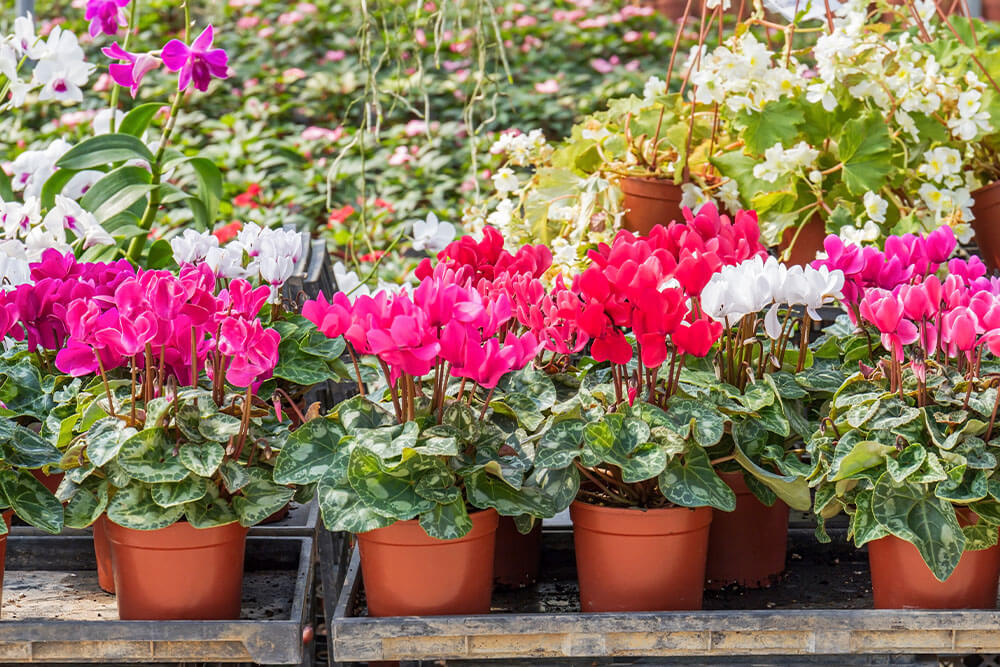
A wonderful shade plant for pots, both inside and out. Thriving in shade, Cyclamen sends up masses of delicate 1 ½ inch butterfly-like blooms in late summer. Just 4 to 6 inches tall, the heart-shaped foliage is marbled in green, cream, and silver and lasts through winter. Plants spread, taking over the plants’ container, up to 10 to 12 inches. Hardy Cyclamen can be moved inside for the winter to use as a houseplant. It can also be planted out in the garden in USDA hardiness zones 3 to 9. It is lovely in woodland settings and rock gardens.
15. Primrose (Primula Vulgaris)
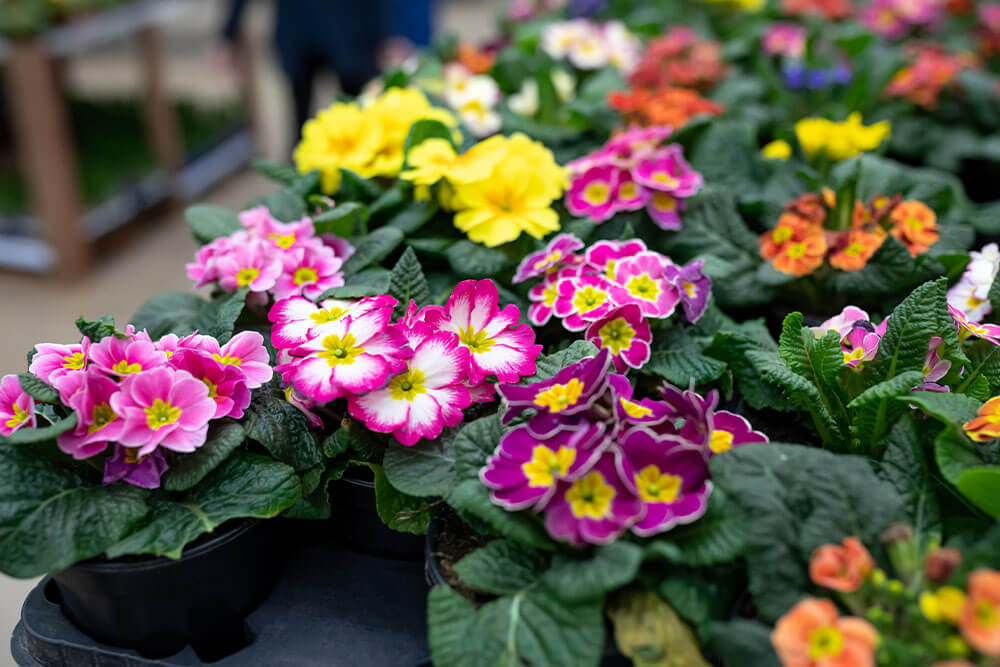
For the love of color, we have Primrose. A rainbow of color options in the various flower forms of the over 500 types of Primrose. From the striking basal rosette of vibrant green wrinkled leaves, Primrose flowers are one of the first to bloom, usually in early April. Thriving in the shade, plant masses of Primrose in containers to brighten areas in early spring. Once the flower show is over, entire containers can be placed in less conspicuous areas to await next year’s bloom time. Plants can also be planted out in the garden in USDA hardiness zones 4 to 8.
16. Lily Of The Valley (Convallaria Majalis)
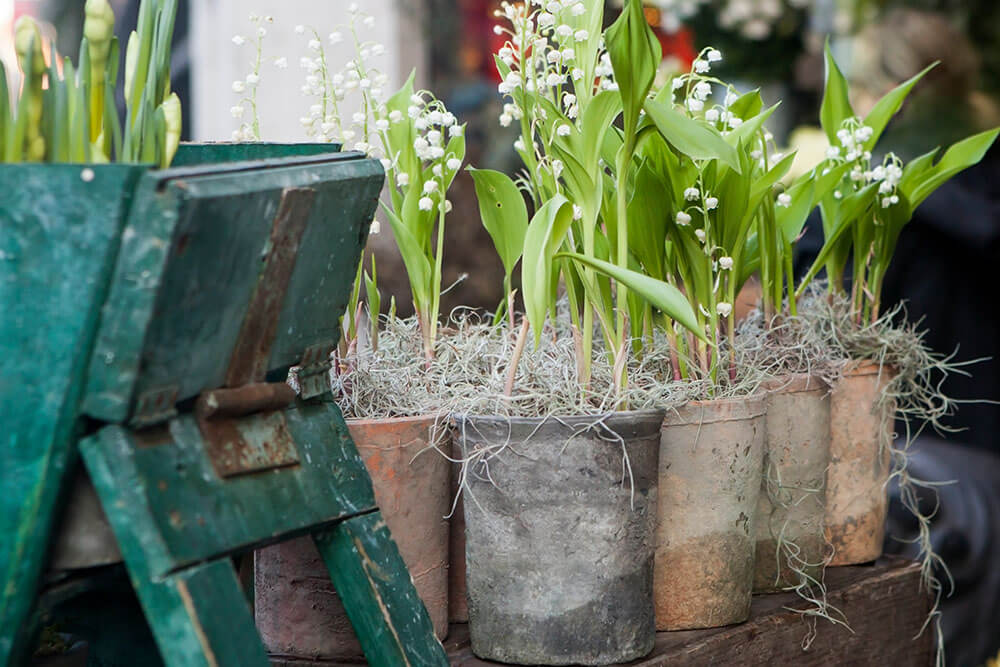
A similar protocol as Primrose can be undertaken for Lily of the Valley. A delightful spring blooming perennial with romantically scented bell-shaped flowers, Lily of the Valley is a perfect shade plant for pots. In the ground, Lily of the Valley grows as a groundcover, spreading 1 to 2 feet with 10-inch lush green oblong pointed leaves. A lovely container plant, the leaves can fill in all the space creating a delightful mass effect. At bloom time, place containers near doors and windows to enjoy the incredible fragrance. When it’s time to divide or thin your Lily of the Valley, use divisions to plant up new pots or plant them in shaded areas of the garden. Lily of the Valley is hardy in USDA 3 to 7.
17. Clivia (Clivia Miniata)

Looking for tropical flair, vibrant blooms, and a showstopping thriller plant for your shade pots? Clivia or Flame Lily is your answer. The voluptuous broadleaf evergreen leaves erupt, arching out from the center of this clumping perennial. A native of South Africa, Flame Lily grows 1 to 2 feet tall and 2 to 3 feet wide. From each central flower stalk emerge gorgeous 2- to 3-inch-long funnel shaped flowers in yellows, oranges, and reds. One stalk may hold as many as 10 to 20 blooms.
18. Camellia (Camellia)

Camellia is a flowering evergreen shrub with dark green, glossy leaves and lusciously large blooms. A delightful plant in warm regions, USDA hardiness zones 7 to 9, Camellia bloom in late fall, winter, and early spring. Depending on variety, Camellia shrubs grow 2 to 12 feet tall, and 2 to 10 feet wide. The lush, multilayered blooms may be white, pink, lavender, red, or yellow. A slow-growing plant, Camellia can be very long lived and are known to outlive their owners. An inspiring legacy plant you could grow in an heirloom planter with the plan to pass it down to the next person in the family who adores shade plants for pots.
Frequently Asked Questions About Shade Plants for Pots
What are the best thrillers for shade?
Persian Shield (Strobilanthes dyeranus) and Clivia (Clivia Miniata) are excellent thriller plants for shade. Both, incidentally, have outstanding tropical appeal. Persian Shield has magnificent exotic foliage and is an exciting thriller shade plant for pots growing 3 to 4 feet tall. When you are looking for tropical flair, vibrant blooms, and a showstopping thriller plant, Clivia or Flame Lily is your answer. Flame Lily grows 1 to 2 feet tall and 2 to 3 feet wide and each central flower stalk holds 2- to 3-inch-long funnel shaped flowers in yellows, oranges, and reds in clusters of 10 to 20 blooms.
What plants should I put in my pots?
You can follow the tried-and-true recipe of a thriller, a filler, and a spiller for exceptional planters every time. Annuals are always fantastic in pots and there are always tons of spiller, filler, and thriller options available. Be adventurous. Try a perennial you love in pots. A shrub can fill the thriller role too. In cold zones, you will want to provide perennials and shrubs winter protection if the planter is out and above ground.
Should you put rocks in the bottom of a planter?
Rocks in the bottom of a planter can give the planter more stability because of their weight. Especially for plants that are tall and upright and must deal with wind. Rocks can provide some drainage but read below on the importance of having drainage holes.
Should I put anything in the bottom of my planter?
High quality potting soil with excellent drainage should be in your planter for your plants to thrive in. But it can seep out of the planter’s drainage holes. Use fiber like coir or landscape fabric to let water through but keep soil in. A layer of small stones or broken pot pieces can also help filter out water and keep soil in.
Is it OK to have a planter without drainage holes?
A planter without drainage holes is a pond. Unless your plants are specifically pond plants, a planter without drainage holes is a death trap for most plants. Plant roots need to breathe, and they can’t breathe well in water-logged non-draining soils like those found in planters without drainage holes.
18 Colorful Shade Plants for Pots for Lighting Up Shaded Areas of The Garden
Shaded areas are a fantastic opportunity to grow gorgeous shade plants for pots. Shade plants for pots make wonderful thrillers, spillers, and fillers. Perennials make excellent shade plants for pots which you can later use as houseplants or plant them out in the garden.
